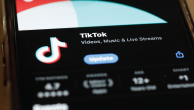To assess ideology, researchers measured three different elements of a site’s news content. They examined the range of viewpoints represented in each story in which the subject involved some matter of disagreement, conflict or controversy. They looked at the narrative frame of the story to see if it reflected one of a detailed list of story themes. Finally, for those stories that were investigative exposes, researchers identified the target of the expose-the subject whose actions were being portrayed as suggestive of controversy or wrongdoing-and noted whether that target was affiliated with a political party or institution.
Researchers then combined these three indicators into a scale in order to create a summary measure of ideology that would be more reliable than any of the individual indicators alone. Sites whose stories tended to lean toward one end of the ideological spectrum and reflected fewer viewpoints scored higher on the 0-100 scale. Sites with content that offered more viewpoints, reflected non-partisan or more evenly divided themes, and whose exposes targeted organizations and people from both sides of the aisle scored lower on the scale.
Using this method, the study found that the ideological character of the 46 sites ranged widely. Some sites evinced no discernible ideological pattern in the balance of viewpoints conveyed, the themes of stories or the targets of exposes. Others showed a clearer ideological hue. All of the sites contained some reporting, in some cases a good deal, that was straightforward accounting of events.
The study also reveals that both liberal and conservative actors have seized the opportunity to enter the news space.
The most consistently ideological content appeared in the two formally organized families of sites-the American Independent News Network sites and the Watchdog.org operations.
The two families of sites scored almost identically on the scale for ideological content. The free-market oriented Watchdog.org sites as a group averaged a 63 on the 100-point scale the study devised to measure ideology. The liberally oriented American Independent News Network together averaged 64.

Some of the commercial sites backed by political sponsors scored even higher on the ideological scale. The site that statistically was most ideological in its content was The Daily Caller, the operation fronted by former cable talk show host and conservative Tucker Carlson. It scored 70. The second highest on the ideological scale was Progress Illinois, a news site with ties to a union group. It scored 65.
In the group of sites that were more loosely associated with one another, the Statehouse News network, no consistent level of ideology emerged. This group, which describes its mission as providing in-depth coverage of state government, included 11 sites in the sample studied. It is made up of independently operated and funded news sites that share content with each other through a system organized by the Franklin Center, the parent of the Watchdog.org sites. Overall, the Statehouse group (at 33) scored lower by about half compared with the Watchdog.org or American Independent News sites, but the individual scores ranged from 0-70. Each of the sites that scored higher on the ideological scale leaned in a conservative direction.
Among the multi-funder sites, which operate independently, none scored higher than 30 for ideology; the average was 11.
To get a better sense of the way content may be colored by partisan sentiment it is useful to break down some of the variables individually.
Range of Viewpoints
[1]
Overall, across the 46 sites, a lack of diverse viewpoints emerged. Indeed, a large majority-nearly two-thirds of stories involving some controversy-contained only a single point of view.
A Colorado Independent story from Oct. 1 was a case in point. It detailed the possible negative impact on libraries if a tax cut measure were to pass in the state. The story quoted four different people, each representing the same pro-library point of view. But it did not include any opposing view in support of the ballot measure.
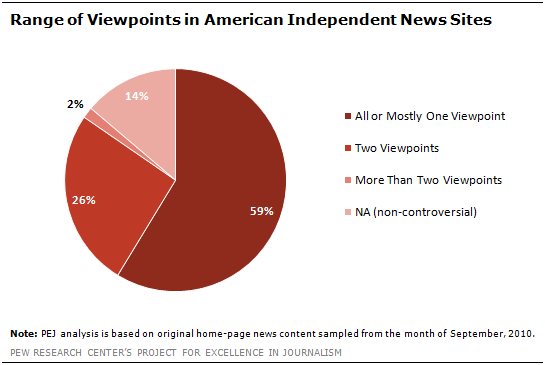
Some sites commonly offered multiple points of view. A Sept. 16 synopsis of a gubernatorial candidates’ debate in MinnPost, for instance, featured three candidates from three different parties-a Republican, a Democrat and a member of the Independence Party, and gave roughly equal space to each of the three candidates and their differing points of view.
Most often, however, the news sites examined tended to reflect one or mostly one side of the story.
The sites that made up the American Independent News Network were the most likely to offer just one perspective on a story. Fully 59% of the articles studied offered all or mostly one point of view, more than double the percentage of stories with two points of view (26%).
Among the other family of sites, the Watchdog.org outlets, the numbers were similar, though slightly less one-sided. The percentage of single-viewpoint stories was 53% while about a third, 32%, included two viewpoints.

Among the Statehouse News network of sites, the share of stories with a single point of view was 50%, compared with 35% that presented two viewpoints.

The individual multi-funder sites tended to present a more diverse range of viewpoints. Of the stories studied, 43% carried one point of view, while 34% carried two. On ProPublica’s site, a majority of stories-52%-featured two viewpoints.

The commercial sites varied in their representation of multiple points of view. They ranged from New West, a news site for the Rocky Mountain region, where 63% of stories had one point of view, to CT News Junkie, a news site specializing in state politics from Hartford, where 46% of stories had one point of view and 36% had two.

Story Theme
Another element of the ideological nature of the reporting is the underlying theme that the story is presenting. Does it evoke an idea associated with a liberal or Democratic point of view, a conservative or Republican point of view, or was there no partisan implication to the overall sense of the story? Researchers examined every assertion in the story, whether from a source being quoted or from the journalist writing the narrative, and checked the ideas present against a detailed list of thematic ideas.
[2]
One theme common in the coverage on sites that leaned in a conservative direction was the idea that government regulation hurts economic growth. An example is a Sept. 2 story in the Nevada News Bureau about a group of Nevada business leaders opposed to federal labor legislation they thought would stifle job growth. While supporters of the legislation were quoted in the piece, most of the article gave voice to opponents of the bill. “Adding burdens, expenses and red tape onto Nevada’s job producers is the fastest way to destroy jobs, not create them,” declared business leader Clara Andriola. Assertions and quotes echoing ideas such as Andrioloa’s outnumbered those on the other side in the story by a ratio of five-to-two, and the story was deemed to reflect primarily a conservative idea.
Conversely, the idea that government helps improve society and quality of life was a theme often found in stories deemed to reflect a liberal perspective. In a Sept. 20 story, for instance, The Michigan Messenger, which is part of the American Independent News Network family, presented a story that unemployment benefits kept millions out of poverty in 2009. “When those benefits expire,” the author of the story wrote, “expect the numbers to get dramatically worse.” The story, though brief, contained no assertions to counter the idea that government is a force for good in society.
Stories with clear partisan themes were most prevalent in the two families of sites.
At the Watchdog.org sites, 41% were crafted in such a way as to support a conservative theme, while 11% reflected pro-liberal themes-a ratio of nearly 4-to-1. (At the same time, 49% reflected a mix of views, or reflected ideas that had no particular ideological theme.)
The overall numbers at the American Independent News Network sites were similar, nearly 4-to-1 liberal to conservative: 37% of the stories carried a pro-liberal theme, either attacking conservative figures, praising liberal ones, or espousing a liberal idea on an issue; 11% heavily reflected conservative ideas; 53% were mixed or non-partisan.
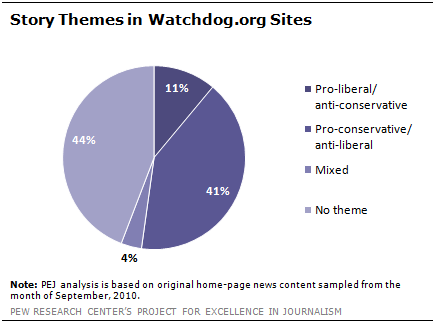
A Sept. 7 story in the Montana Watchdog, a Watchdog.org site that is supported by a think tank called the Montana Policy Institute, exemplified the theme that government regulation hindered economic growth.
The article repeated the idea that the Environmental Protection Agency would kill an emerging new industry, the biomass business, if it succeeded with a proposal to classify plant material as a fossil fuel when it was used to create energy.
Rep. Chas Vincent, head of Montana’s Environmental Quality Council, called the EPA’s proposed change “a quagmire to prohibit (biomass) from being developed…We have some big players at the table looking at getting fiber out of the forest as cost effectively as possible. Then we have another scud missile fly in from a regulatory agency who says if you can get it done, have good luck getting it permitted.”
In all, 10 assertions in the story echoed Vincent’s anti-regulatory sentiments, while only one offered a different viewpoint.
A Sept. 28 story in the Texas Independent, meanwhile, was heavily critical of attempts by the State Board of Education to weed out public school curriculum that it saw as anti-Christian. After the board voted by a margin of 7-to-6 to pass a non-binding resolution against a “pro-Islam, anti-Christian” bias in textbooks, the story quoted Democrat Mary Helen Berlanga-who was unable to attend the vote due to family obligations, about what she called the fanaticism of her opponents. “We are the State Board of Education, not the State Board of Religion,” Berlanga said. “So why are we trying to tie up religion with education? It’s absolutely insane and a waste of time. We should be concentrating on the important issues, like core curriculum or whether or not kids can graduate high school. One of the board’s fanatics wants to make sure he does as much damage as he can before he leaves,” said Berlanga, pointing in the direction of former chair Don McLeroy (R-Bryan).
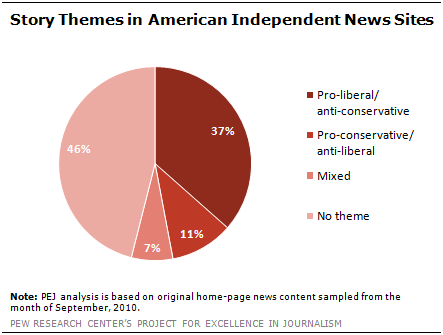
All of the assertions made in this story reflected this viewpoint; none supported an opposing idea.
Sites with multiple funders, and sites that belonged to only informal networks or none at all, tended to be more balanced in their reporting.
The more loosely connected Statehouse News consortium reflected some pro-conservative orientation, but the ratio was much less than at the Watchdog.org or American Independent sites. Nearly a quarter of the stories (23%) reflected clearly conservative themes, while 13% reflected liberal themes, a ratio of less than 2-to-1. Most of the stories produced by sites affiliated with Statehouse News Online (64%) were mixed or contained no discernable theme.
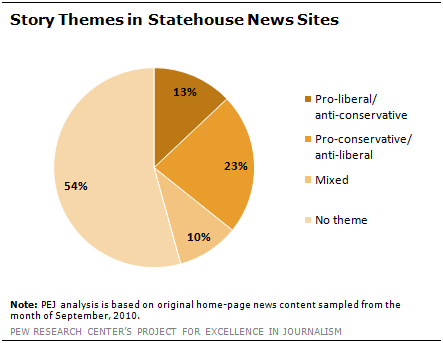
Many of the stories that reflected no particular partisan tilt (two-thirds of all Statehouse News Online stories studied) reported on state affairs in a way that simply shed light on complex procedural and political matters, according to the research. A Sept. 23 Illinois Statehouse News story, for instance, interviewed two experts to clarify the confusing timeline of events in the Senate race in which candidates had to campaign in two separate but simultaneous contests: one, for the regular six-year senate term (once held by Barack Obama), the other to replace the controversially appointed Roland Burris, who was being forced to step down after a federal court ruled it was unconstitutional for him to finish out Obama’s full term.
The individual multi-funder sites were even more likely to be primarily mixed or balanced in the themes reflected in their stories.
At ProPublica, the national investigative news operation, for instance, 67% of the stories reflected either a mix of ideas or no theme at all. Of those that did evoke partisan themes, 14% reflected primarily conservative ideas while 19% reflected primarily liberal. At California Watch, a state-oriented investigative site in San Francisco that is a project of the Center for Investigative Reporting, more than 80% of the stories reflected a mix of ideas or themes that were not partisan in nature.
The Connecticut Mirror, a site founded in 2010 and staffed with a number of veterans of the Hartford Courant, included more ideologically themed coverage but in equal proportions. In the time period studied, 21% of the stories projected largely pro-liberal themes, and 21% contained pro-conservative themes.

A typical example of Connecticut Mirror’s reporting, from a Sept. 23 story, was a guide to the federal health care reform law. The lengthy piece billed itself as a primer to help “decode” the various aspects of the legislation, including changes that affect all health insurance plans, changes that affect only some plans, what it means for a plan to be ‘grandfathered,’ and the impact on rates. The story included information provided by a health insurance company, Anthem, but also included a quote by Health and Human Services Secretary Kathleen Sebelius “blasting” some insurers for misinforming enrollees.
At MinnPost, nearly two-thirds of the coverage, 64%, contained no discernable theme. In the smaller pool of stories that did, more pro-liberal ideas came through: 23% of the stories studied presented a pro-liberal theme while 5% were conservative.
There was somewhat less balance among the seven commercial sites studied. At Progress Illinois, a commercial site launched with a founding sponsorship from the SEIU Illinois State Council, 44% of the stories reflected liberal ideas. Another site, New West, tilted more than 3-to-1 liberal in its themed content.
By contrast, at The Daily Caller, the commercial site started by conservative television personality Tucker Carlson, 42% of the stories were pro-conservative, while just 4% were pro-liberal in nature. And at the Sunshine State News, 30% of stories were clearly conservative while 15% reflected liberal themes and 55% were either mixed or contained no discernable theme.
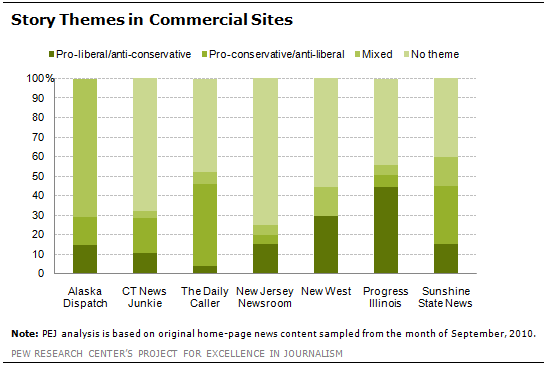
On Sept. 30, The Sunshine State News, whose seed investors are unknown to the public, published one of a number of pieces during the month critical of Democratic House candidate Alan Grayson, trying to tie him to Obama. This passage, which comes from the journalist authoring the piece rather than any source cited, was typical: “The one constant between 2008 and 2010 is ‘change.’ Barack Obama and Grayson ran successfully on that theme in 2008. But ‘change‘ is on the Republicans’ side this year, and Grayson’s rhetorical fusillades are sputtering.”
Target of Exposes
A third way to assess the ideology of news reports is to identify the target, or alleged culprit, in any exposes the news site published. When a site was trying to reveal something untoward, in other words, who was the journalist targeting for misconduct?
Here is it important to note that the vast majority of stories studied-usually more than 80%-were not exposes. But among those that were, the study found differences in who was put under the microscope.
Among Watchdog.org sites, most stories studied (85%) did not target any individual or organization for wrong-doing. But 15% were exposes. And most of those targeted a Democrat, a Democratic program, a Democratic-led state or the federal government (11% of all stories studied). A smaller amount, 2% of all stories studied, targeted Republicans.
On nine of the 12 Watchdog.org sites, only Democrats or government agencies were the subject of investigative exposes.
The American Independent News Network, whose content and mission lean liberal, were more likely than any group to target businesses for wrong-doing; 7% of the stories studied fit this category, while 1% of all stories targeted Democrats or the federal government.
Sites belonging to the Statehouse News consortium were slightly less likely than most to publish work aimed at exposing wrongdoing. Only 11% of their combined stories fit this category. Democrats and the federal government made up slightly more of the targets in these expose pieces than Republicans and business interests did, but there were too few of each to indicate a trend.
When it came to the individual multi-funder news sites, researchers found a range of results. Some sites clearly prioritized these kinds of targeted exposes more than others. The Connecticut Mirror, for instance, produced such pieces only 6% of the time during the sample month studied. But at ProPublica, 34% of the stories studied were investigations that clearly targeted a partisan program or person. In most cases, neither Democrats nor Republicans were spared. ProPublica targeted government agencies just as often as it targeted business interests. Similarly, the Texas Tribune, at which 20% were exposes, targeted Democratic lawmakers just as often as it did Republican ones.
For the most part, the commercial sites that were studied did not produce a high volume of investigative stories. The two sites that published the highest percentage were Alaska Dispatch and Sunshine State News. At Alaska Dispatch, where 15% of the stories were exposes, half targeted Republicans, and none targeted Democrats. At Sunshine State News, where 12% of stories were exposes, the majority of these kinds of stories targeted either Democrats or moderate independent candidates for office.
[1]
[2]
